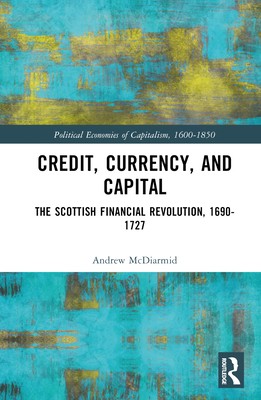
- We will send in 10–14 business days.
- Author: Andrew McDiarmid
- Publisher: Routledge
- ISBN-10: 1032257431
- ISBN-13: 9781032257433
- Format: 15.6 x 23.4 x 1.3 cm, hardcover
- Language: English
- SAVE -10% with code: EXTRA
Reviews
Description
The years 1690-1727 represented a period of significant change for Scotland. It was a time of grand colonial endeavours and financial innovation, punctuated by bouts of economic turmoil and constitutional and political uncertainty. The infamous Darien Scheme, the establishment of the Bank of Scotland and the Royal Bank of Scotland, the Anglo-Scots Union, the Hanoverian Succession, and the Jacobite rising of 1715, all occurred during this short time span. It was therefore a period which presented Scotland with opportunities, but one in which the country ultimately lost its autonomy. It was also during these years, and against this unsettled backdrop, that the Scottish Financial Revolution commenced.
The complexity of the Scottish situation during the late seventeenth and the early eighteen centuries has historically made the identification of a Scottish Financial Revolution difficult. This monograph, the first dedicated to the topic, addresses this problem, and provides a model for identifying and understanding the revolution through the economic, political, and constitutional contexts of the period. Using examples of financial developments and innovation driven by Scotsmen in Scotland, Europe, and the colonies, this work defines the Scottish Financial Revolution as a series of developments which took place in Scotland when political circumstances allowed, but which also occurred outwith Scotland through the agency of members of the Scottish diaspora. This monograph is therefore the story of how Scotsmen at home and abroad contributed to financial debate and development between 1690 and 1727.
Credit, Currency, and Capital: The Scottish Financial Revolution, 1690-1727 will appeal to students and scholars interested in the History of Economics and Finance. It will also be of interest to those studying the history of the Anglo-Scots Union and the complex relationship between Scotland and England.
EXTRA 10 % discount with code: EXTRA
The promotion ends in 19d.11:34:26
The discount code is valid when purchasing from 10 €. Discounts do not stack.
- Author: Andrew McDiarmid
- Publisher: Routledge
- ISBN-10: 1032257431
- ISBN-13: 9781032257433
- Format: 15.6 x 23.4 x 1.3 cm, hardcover
- Language: English English
The years 1690-1727 represented a period of significant change for Scotland. It was a time of grand colonial endeavours and financial innovation, punctuated by bouts of economic turmoil and constitutional and political uncertainty. The infamous Darien Scheme, the establishment of the Bank of Scotland and the Royal Bank of Scotland, the Anglo-Scots Union, the Hanoverian Succession, and the Jacobite rising of 1715, all occurred during this short time span. It was therefore a period which presented Scotland with opportunities, but one in which the country ultimately lost its autonomy. It was also during these years, and against this unsettled backdrop, that the Scottish Financial Revolution commenced.
The complexity of the Scottish situation during the late seventeenth and the early eighteen centuries has historically made the identification of a Scottish Financial Revolution difficult. This monograph, the first dedicated to the topic, addresses this problem, and provides a model for identifying and understanding the revolution through the economic, political, and constitutional contexts of the period. Using examples of financial developments and innovation driven by Scotsmen in Scotland, Europe, and the colonies, this work defines the Scottish Financial Revolution as a series of developments which took place in Scotland when political circumstances allowed, but which also occurred outwith Scotland through the agency of members of the Scottish diaspora. This monograph is therefore the story of how Scotsmen at home and abroad contributed to financial debate and development between 1690 and 1727.
Credit, Currency, and Capital: The Scottish Financial Revolution, 1690-1727 will appeal to students and scholars interested in the History of Economics and Finance. It will also be of interest to those studying the history of the Anglo-Scots Union and the complex relationship between Scotland and England.


Reviews